
Home |
Learning Astronomy |
Astronomy Software |
Links |
Amateur Astronomy Projects |
Books
Solar System Exploration |
Pluto |
Space Telescopes |
Space Stations |
Space Tourism |
Earth |
Meteorology |
The Milky Way
Catalogues and Pictures |
Telescopes |
Videos |
Places To Visit |
My Projects
2012 and Planet X |
Aliens & UFO |
Astronomy & The Bible |
News |
Contact
Pluto (1) (previously classified as a planet, called 9th Planet for decades) | a Trans-Neptunian Object (TNO)
aka asteroid number 134340
5 known moons (Charon, Nix, Hydra, Kerberos and Styx)
New Horizons see also here see also here Pluto (Jul 17, 2015)
N E W H O R I Z O N S A T P L U T O N O W
2015-07-13 How Big Is Pluto? New Horizons Settles Decades-Long Debate - Alex Jones' Infowars
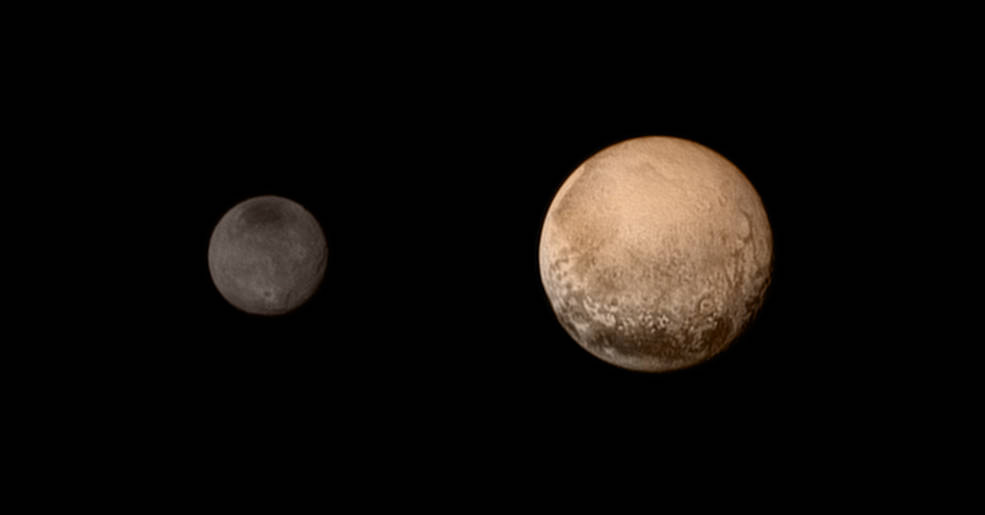
Pluto and Charon Jul 11, 2015
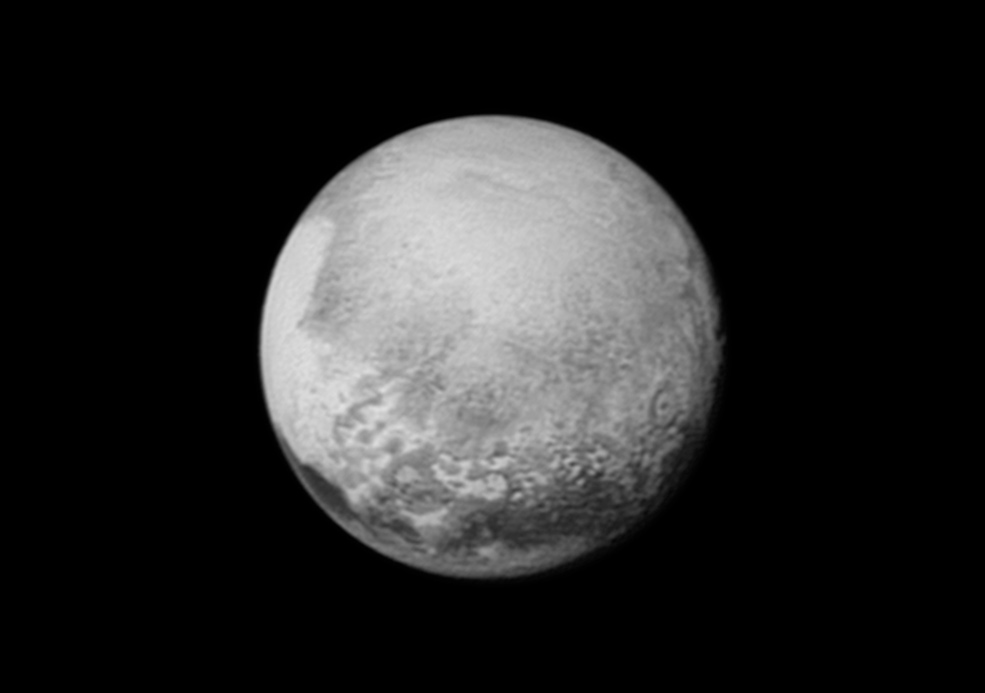
Pluto’s bright, mysterious “heart” is rotating into view, ready for its close-up on close approach, in this image taken by New Horizons on July 12 from a distance of 1.6 million miles (2.5 million kilometers). It is the target of the highest-resolution images that will be taken during the spacecraft’s closest approach to Pluto on July 14. The intriguing “bulls-eye” feature at right is rotating out of view, and will not be seen in greater detail.
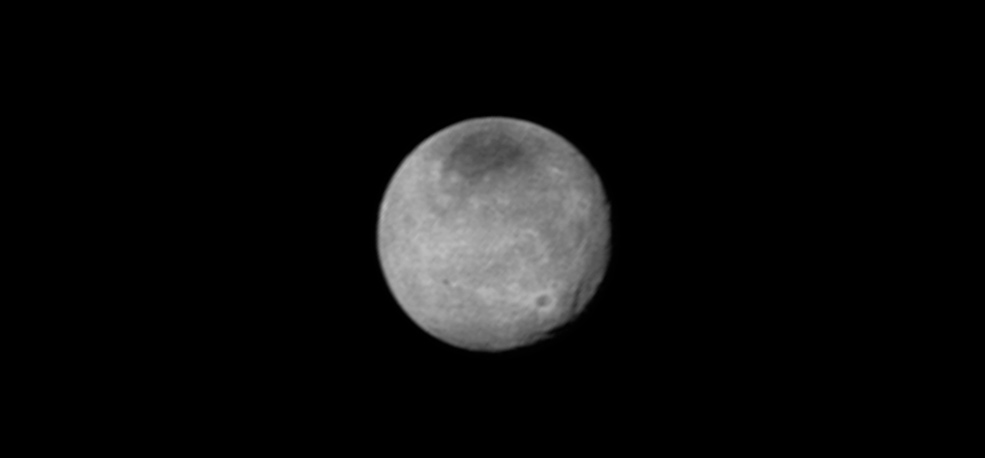
Charon’s newly-discovered system of chasms, larger than the Grand Canyon on Earth, rotates out of view in New Horizons’ sharpest image yet of the Texas-sized moon. It’s trailed by a large equatorial impact crater that is ringed by bright rays of ejected material. In this latest image, the dark north polar region is displaying new and intriguing patterns. This image was taken on July 12 from a distance of 1.6 million miles (2.5 million kilometers).
|
NASA’s New Horizons mission has answered one of the most basic questions about Pluto—its size. Mission scientists have found Pluto to be 1,473 miles (2,370 kilometers) in diameter, somewhat larger than many prior estimates. ... This result confirms what was already suspected: Pluto is larger than all other known solar system objects beyond the orbit of Neptune.
Pluto’s newly estimated size means that its density is slightly lower than previously thought, and the fraction of ice in its interior is slightly higher. Also, the lowest layer of Pluto’s atmosphere, called the troposphere, is shallower than previously believed.
New Horizons observations of Charon confirm previous estimates of 751 miles (1208 km) kilometers) across.
Nix and Hydra were discovered using the Hubble Space Telescope in 2005. ... Nix is estimated to be about 20 miles (about 35 kilometers) across, while Hydra is roughly 30 miles (roughly 45 kilometers) across. These sizes lead mission scientists to conclude that their surfaces are quite bright, possibly due to the presence of ice.
What about Pluto’s two smallest moons, Kerberos and Styx? Smaller and fainter than Nix and Hydra, they are harder to measure. Mission scientists should be able to determine their sizes with observations New Horizons will make during the flyby and will transmit to Earth at a later date.
|
2015-07-13 NASA’s New Horizons probe finds Pluto is bigger than predicted - Reuters
|
Pluto’s diameter also affects the size of its atmosphere, which New Horizons has learned is bleeding off into space at a faster rate than expected.
The nuclear-powered probe was in position to pass dead center of a 60-by-90-mile (97-by-145 km) target zone between the orbits of Pluto and its primary moon, Charon, at 7:49 a.m. EDT on Tuesday
Most of New Horizons’ data will be stored on the spacecraft and transmitted back to Earth after the probe passes beyond the Pluto system. Flight controllers expect to receive just a short message from New Horizons around 9 p.m. on Tuesday that it survived the Pluto encounter.
Lead scientist Alan Stern said there was a one-in-10,000 chance that a debris strike could destroy New Horizons as it nears Pluto.
|
2015-07-13 Little Pluto bigger than scientists thought as flyby looms - Phys.org
|
Measurements by the spacecraft set to sweep past Pluto on Tuesday indicate the diameter of the dwarf planet is 1,473 miles, plus or minus 12 miles. That's about 50 miles bigger than previous estimates in the low range.
Three new discoveries were revealed Monday ... Besides the revised size of Pluto ... scientists have confirmed that Pluto's north pole is indeed icy as had been suspected. It's packed with methane and nitrogen ice. And traces of Pluto's nitrogen-rich atmosphere have been found farther from the dwarf planet than anticipated. ...
Pluto is the largest object in the so-called Kuiper Belt, considered the third zone of the solar system after the inner rocky planets and outer gaseous ones. This unknown territory is a shooting gallery of comets and other small bodies; every time one of these wayward objects smack one of Pluto's five known moons, the ejected material ends up in orbit around Pluto, thus the debris concern. An extension of the $720 million mission, not yet approved, could have New Horizons flying past another much smaller Kuiper Belt object, before departing the solar system.
|
2015-07-11 - New Horizons’ Last Portrait of Pluto’s Puzzling Spots - NASA
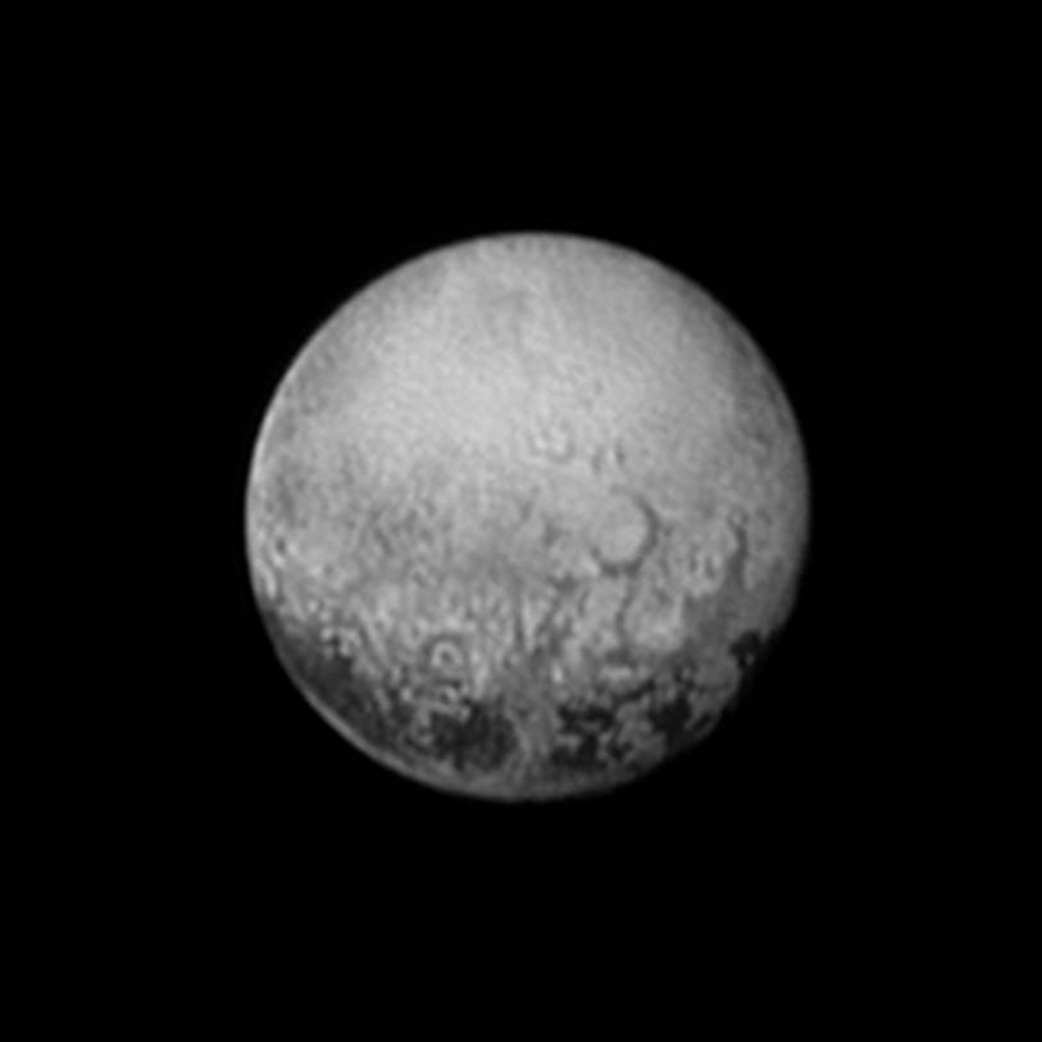
“the last, best look that anyone will have of Pluto’s far side"
2015-07-11 - Pluto may reveal secret of Earth's creation - The Telegraph
|
When Pluto was discovered in 1930, a competition was held to find a name for the new planet. Eleven-year-old Venetia Burney chose Pluto because it was dark and far away, like the god of the underworld. She received a £5 note as a reward.
|
2015-07-11 - Scientists simulate the space environment during New Horizons flyby - Phys.org
See also Tracking Space Weather - SpaceRef
2015-07-10 Pluto sweats, and 5 other things you didn't know about the dwarf planet - Phys.org
|
- Day length: Pluto takes much longer to complete a full rotation than Earth does, making a day there equal to nearly six and half Earth days. A Pluto year is about 248 Earth years.
- Composition: Basically, Pluto is a huge chunk of rock covered in a relatively thin layer of ice, with nitrogen ice on the surface - and very possibly, water ice between that and the rock.
- Atmosphere: Pluto doesn't have an atmosphere like ours. It's about 100,000 times less dense than ours, because the planet is "sweating". It's mostly nitrogen, with traces of methane and carbon dioxide, that sublimate – or move from solids directly to gases – off the surface to produce this thin "atmosphere".
- Distance: On average, Pluto is about 40 times further from the Sun than the Earth (it varies between 39 times and 50 times because its orbit is elliptical). That's between 4.4 and 7.4B km from the Sun.
- Seasons: Pluto's seasons are extreme and long. Earth's seasons are caused by its tilt (23.5 degrees). To give you some perspective, Pluto's tilt is 120 degrees!
- Orbit: Pluto and its largest moon, Charon, orbit in such a way that the same moon face is always seen from Pluto's surface – just like Earth and its Moon. But Charon is also always in the same spot in Pluto's sky, meaning that if you're on the wrong side of Pluto, you'd never see the moon.
|
2015-07-11 New Image of Pluto: 'Houston, We Have Geology' - Phys.org See also SpaceRef article
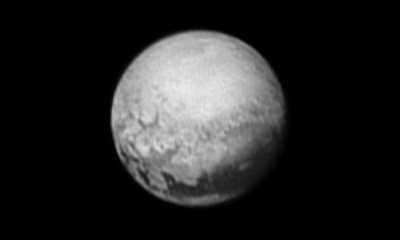
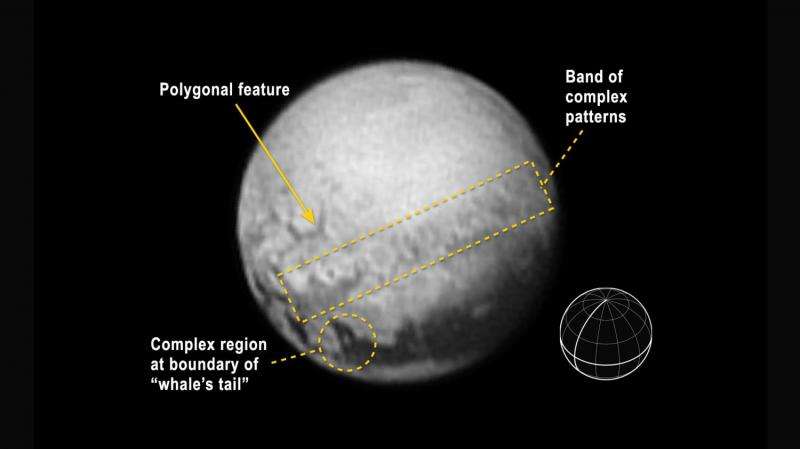
2015-07-10 Distant Pluto finally gets its day in the sun - Reuters
|
Six months after New Horizons launched and with more than 40 Kuiper Belt objects on the books, the International Astronomical Union made a controversial call to reclassify Pluto as a “dwarf planet.” Astronomers have since discovered about 2,000 more Kuiper Belt residents out of a population estimated at hundreds of thousands. Ironically, it was the discovery of the Kuiper Belt that provided the scientific motivation and money for a mission to Pluto. Scientists believe the Kuiper Belt holds fossils from the formation of the solar system 4.6 billion years ago. New Horizons will conduct its science on the fly, much like NASA’s Pioneer, Mariner and Voyager missions of the 1960s to the 1980s, when exploration of the solar system began.
Timing is crucial. New Horizons will have just 30 minutes to conduct the most important part of the mission, including photographing Pluto and Charon, determining what the icy worlds are made of and scanning Pluto’s atmosphere - all done while the probe and Pluto finally cross paths.
|
2015-07-10 New Horizons' close encounter with Pluto will reveal its icy secrets about New Horizons
2015-07-10 NASA missions have their eyes peeled on Pluto - Phys.org various Pluto observations also happening
2015-07-09 12 things to know about Pluto - CNN
2015-07-09 New Views of Pluto and Charon - SpaceRef
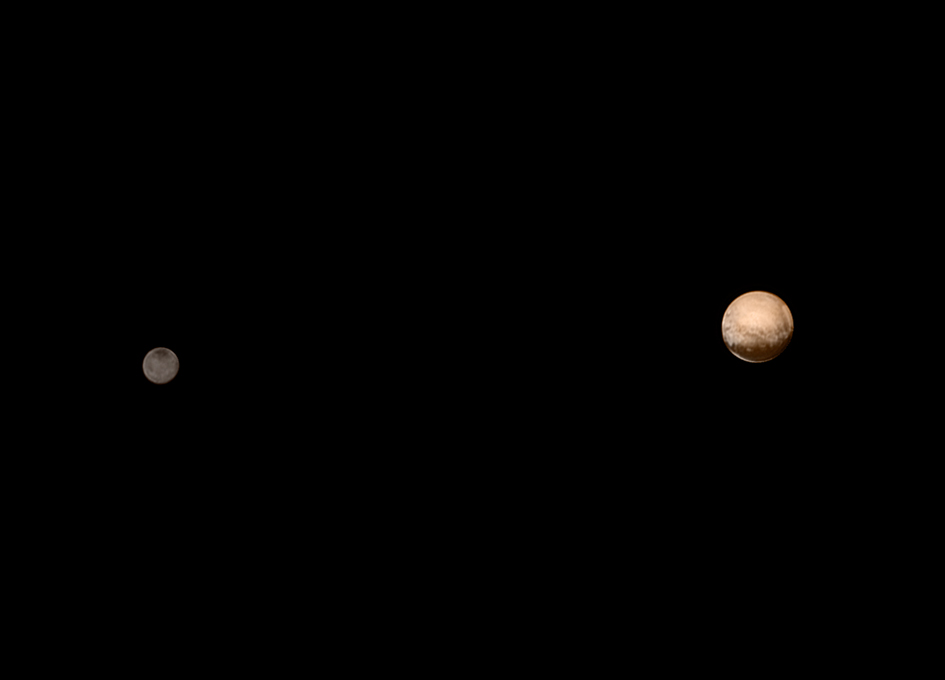
2015-07-09 Giant heart spotted on Pluto in closest ever pictures of dwarf planet - The Telegraph
|
The probe will arrive at the dwarf-planet carrying the ashes of discoverer Clyde Tombaugh. Tombaugh died on January 17 1997, nine years and two days before New Horizon’s launch, but one of his final requests was for his ashes to be sent into space. A small container carrying his remains is affixed to the insider of the upper deck of the probe bearing the inscription: “Interned herein are remains of American Clyde W. Tombaugh, discoverer of Pluto and the solar system's 'third zone'” It is fitting that when New Horizon first set off in January 2006, carrying Tombaugh’s ashes, Pluto was still considered a planet. But just a few months later it was downgraded to a dwarf-planet or ‘plutoid’ and is now known unceremoniously as ‘asteroid number 134340’
|
2015-07-09 Pluto's 'heart' revealed as New Horizons probe starts flyby campaign - Phys.org
2015-07-08 New Image of Pluto - SpaceRef
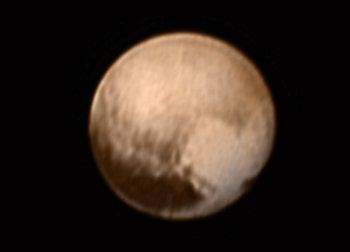
2015-07-07 New Horizons Map of Pluto: The Whale and the Donut - SpaceRef
2015-07-07 New Horizons Got Too Excited and Passed Out on July 4th - Wired
2015-07-04 New Horizons Spacecraft In Safe Mode - SpaceRef
2015-07-06 New Horizons probe lost communication for an hour over the weekend, but everything is probably fine - ExtremeTech
2015-07-06 NASA Says New Horizons Pluto Probe Is Okay After a Scary Glitch - Time
2015-07-05 New Horizons spacecraft experiences anomaly - Phys.org
2015-07-05 New Horizons space probe suffers glitch on approach to Pluto - Reuters
2015-07-04 New Horizons Spacecraft In Safe Mode - SpaceRef
2015-06-23 8-Bit Video Shows the Moon Charon Orbiting Pluto - Wired
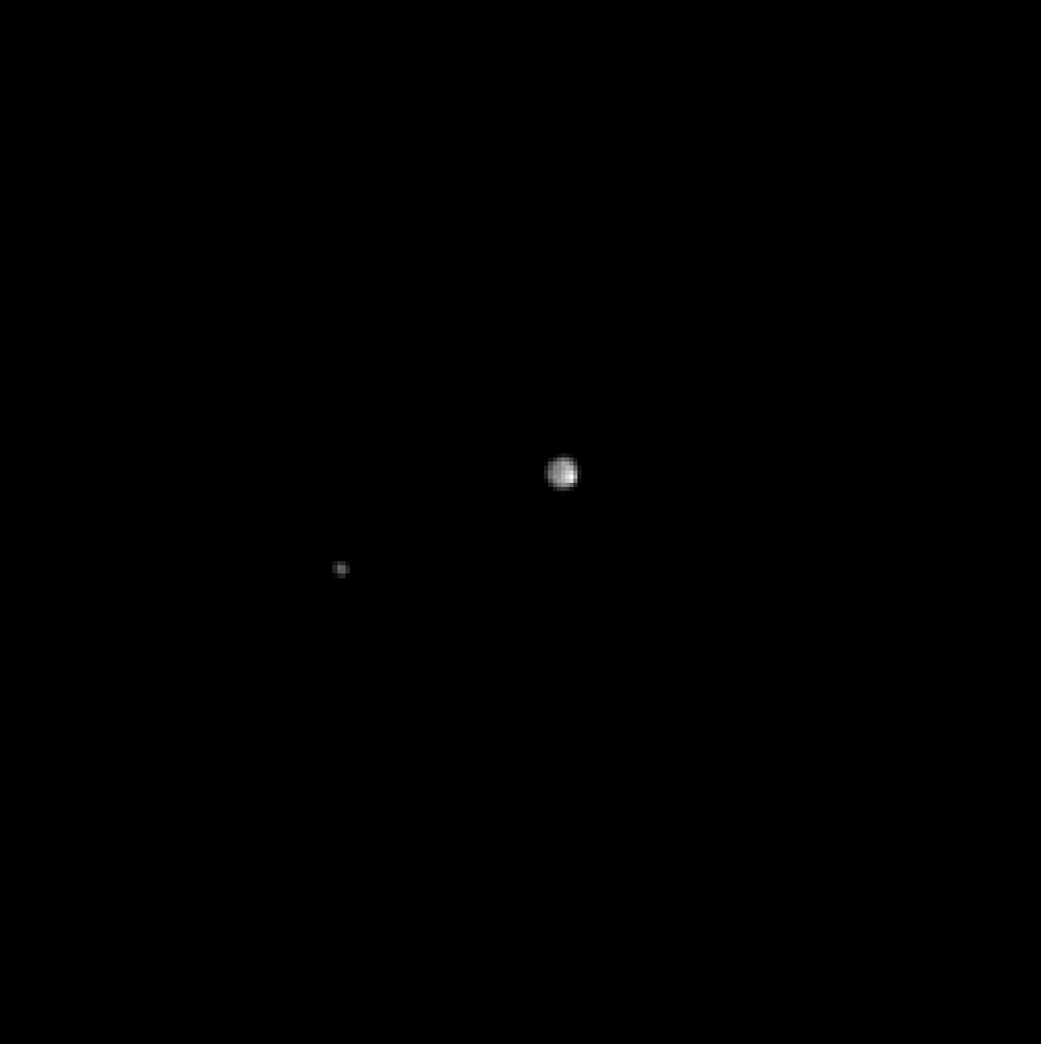
2015-06-22
Pluto and Charon: The First Color Movie - SpaceRef
2015-06-03
NASA’s Hubble Finds Pluto’s Moons Tumbling in Absolute Chaos - NASA
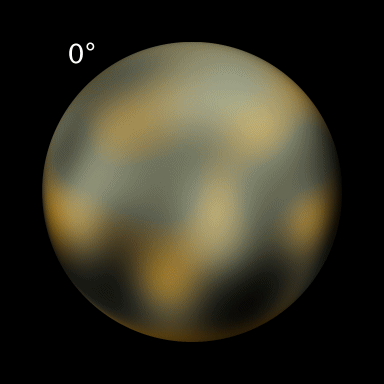
About Pluto (Before New Horizons)
1930-02-18 Pluto discovered by 23-year-old Lowell Observatory astronomer Clyde Tombaugh
1977 moon Charon was discovered
2011 moon Kerberos was discovered
2012 moon Styx was discovered
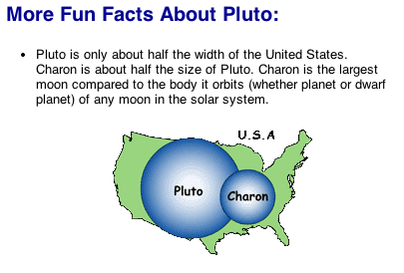
Facts about Pluto. Credit: NASA
Pluto was the first member of the Kuiper Belt to be found. The Kuiper Belt, a part of the Solar System long theorized but only confirmed beginning in 1992, is the “third realm” of bodies orbiting the Sun after the Sun-hugging realm of the rocky planets and the realm of the giant planets. It is far bigger than the first two realms combined. As New Horizons closes in on Pluto, we know of over 1000 bodies in trans-Neptunian space. Astronomers estimate that more than 100 times that number might exist. Assuming that New Horizons continues to operate as planned, mission planners expect to direct it past several more Kuiper Belt Objects after the Pluto flyby.
Pluto’s atmosphere, like the earth’s, is primarily made of nitrogen. On Pluto, however, the next most abundant component is methane. Methane, like other hydrocarbons, decomposes in sunlight and eventually turns into increasingly more complex molecules. Hydrocarbons that are released from the surface of Pluto and go into the atmosphere suffer the same ultimate fate as hydrocarbons that are emitted from a car tailpipe and go into the skies of Los Angeles: they become haze.
Source
2006-08 Pluto demoted, by the International Astronomical Union, from Planet to Dwarf Planet
What makes a planet in the solar system? According to the IAU's definition, it must orbit the sun, it must be big enough for gravity to crush it into a nearly round shape, and it must clear the neighborhood around its orbit. In other words, it must be dominant enough to clear away objects in its orbital space, according to NASA. This last point is what proved to be Pluto's demise as a planet: There are other competing objects in its orbit.
Some scientists say that part of the definition doesn't make sense. "It's kind of like, I'm going to tell you what your car is on the basis of how the traffic around you is behaving," said Mark Sykes, director of the Planetary Science Institute.
The IAU's decision also came under fire because only 4 percent of its scientists participated in the vote that reclassified Pluto. But Christensen said the IAU was following its statutes and bylaws and has passed other resolutions in a similar way. Source
RECOMMENDED ARTICLES
2014-06-14 Pluto: Doorway to the Stars (1962) on history of Pluto
The Pluto system as observed by the Hubble Space Telescope in July 2012
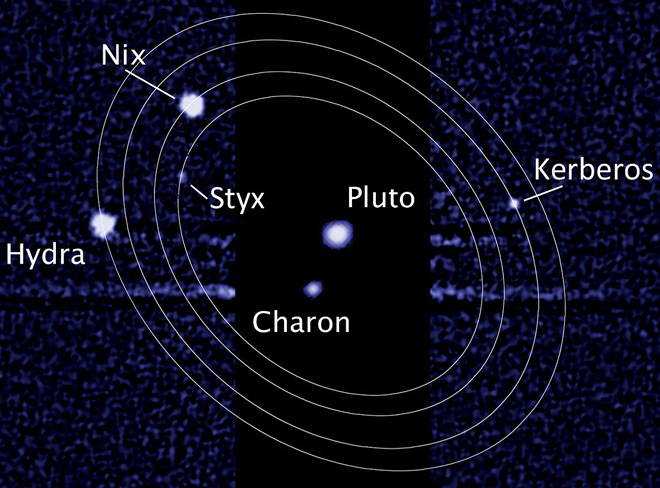
Jul 12, 2012 Hubble Discovers a Fifth Moon Orbiting Pluto
Jul 11, 2012 Hubble telescope spots fifth moon near Pluto
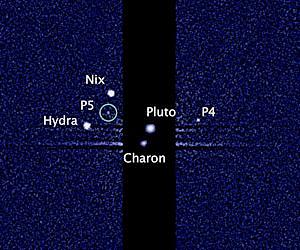
Sep 5, 2011 Dwarf Planet Mysteries Beckon to New Horizons
Jul 20, 2011 Tiny fourth moon discovered in Pluto's orbit
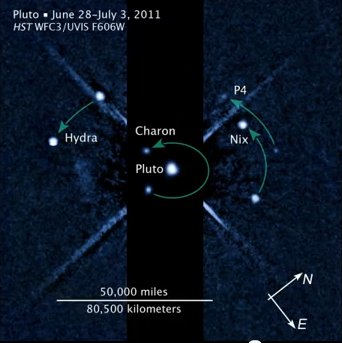
Oct 31, 2011 Pluto — No Longer a Planet — Has a Twin Sister
Oct 18, 2010 Reaching the Mid-Mission Milestone on the Way to Pluto
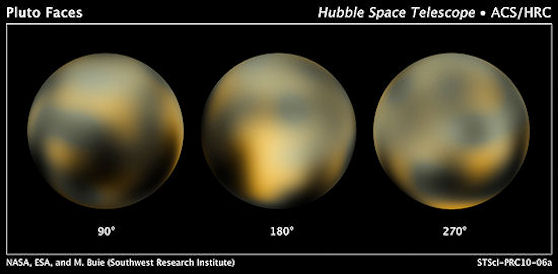
© 2006 - 2015 Nigel Romany
|















